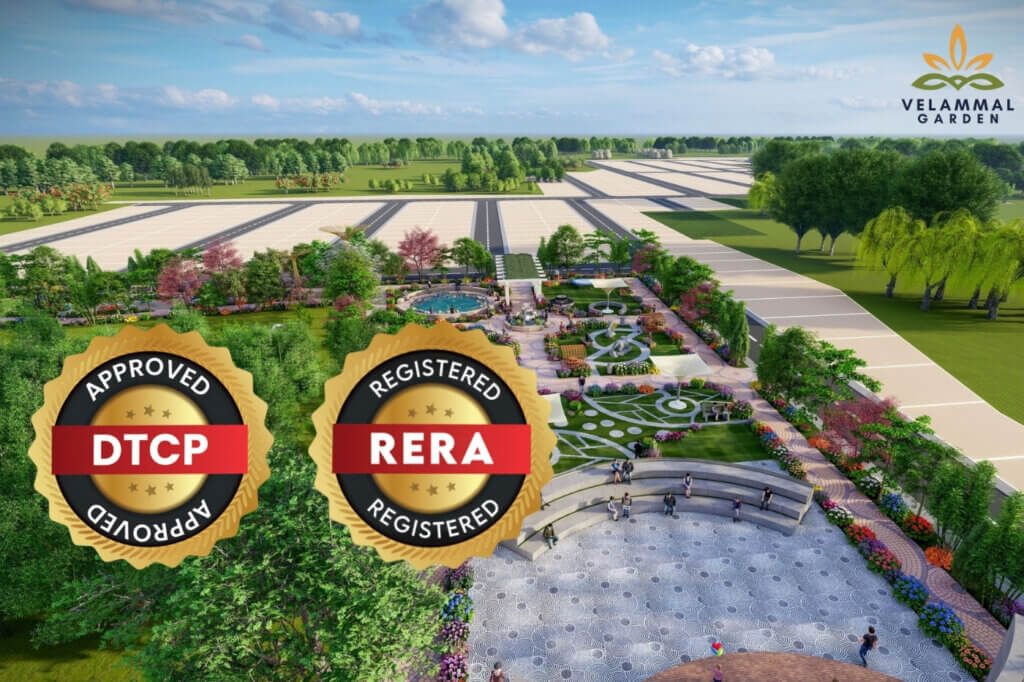A plot’s price has two faces in Tamil Nadu. One is the government-published “guideline value” used for levying duties. The other is the real-world “market value” that buyers and sellers negotiate. Understanding the gap between these two helps you avoid penalties, plan taxes smartly, and register your Padappai or Oragadam plot smoothly.

What is Guideline Value and Why It Exists
Guideline value is the “ready-reckoner” rate notified by the Registration Department for each survey number or street. It’s a reference for:
- Calculating stamp duty and registration charges
- Detecting under-valuation in sale deeds
- Ensuring uniformity across localities
Guideline values are updated in cycles and may not fully capture recent demand, infrastructure growth, or micro-location factors. That’s why in fast-moving belts like Padappai–Oragadam, market value often runs ahead.
What is Market Value and How It’s Set
Market value is simply what a willing buyer pays a willing seller. It reflects:
- Current demand from nearby industries and warehousing
- Arterial road connectivity and upcoming infra
- Community features, amenities, and approvals
- Plot attributes like frontage, facing, width of approach road, and corner advantage
For example, a DTCP-approved, RERA-compliant gated layout with wide blacktop roads in Padappai can command a premium over the guideline value because buyers pay for certainty, infrastructure, and future upside.
Which Value Is Used for Registration
At the Sub-Registrar Office (SRO), stamp duty and registration charges are generally computed on the higher of:
- Declared sale consideration, or
- Guideline value for that survey number/street
In Tamil Nadu, for a typical sale deed, stamp duty is commonly 7% and registration charges 4% of the assessable value. Always verify current rates at the time of registration; policies can change.
Income-Tax Angle: Sections You Must Know
When market value and guideline value differ, two key provisions often kick in:
Section 50C (Seller’s capital gains)
If the declared sale consideration is lower than the stamp-duty value (SDV, usually aligned with guideline value), capital gains are computed on the SDV.
- Example: You sell a plot at ₹45,00,000 but the SRO value is ₹50,00,000. For capital-gains calculation, ₹50,00,000 becomes the deemed sale value.
- Relief: You may request a reference to a Valuation Officer if you believe the SDV is higher than fair market value.
Section 56(2)(x) (Buyer’s taxation on undervalued purchase)
If a buyer purchases an immovable property for less than the SDV, the difference may be taxed as “income from other sources” in the buyer’s hands, if it exceeds the higher of ₹50,000 or a safe-harbour percentage (commonly 10%) of the consideration.
- Example: You buy at ₹45,00,000 while SDV is ₹50,00,000. The difference is ₹5,00,000. Ten percent of ₹45,00,000 is ₹4,50,000. Since ₹5,00,000 exceeds both ₹50,000 and ₹4,50,000, the excess ₹5,00,000 could be taxable for the buyer.
TDS under Section 194-IA (Buyer’s deduction at source)
If consideration is ₹50,00,000 or more, the buyer generally deducts 1% TDS from the sale consideration at the time of payment and deposits it to the government. Keep your documents and PANs ready so credit flows correctly.
Practical Implications for Padappai–Oragadam Buyers
- If your negotiated market price is below guideline value, your duty outgo may still be computed on guideline value, and tax provisions like 56(2)(x) can apply in the buyer’s hands.
- If your market price is above guideline value (common in growth pockets), duties and taxes will follow your higher actual consideration; no undervaluation issues, but your overall cash outflow rises.
How to Handle a Wide Gap Between Values
- Seek a valuation note: Request recent comparable sale deeds in the same micro-pocket to justify market price.
- Document the attributes: Corner plot, wider road, proximity to a park or school, better frontage — these justify premiums over guideline value.
- Consider a professional valuation: A registered valuer’s report can be useful for 50C/56(2)(x) positions.
- Plan your tax: Speak to a CA on capital-gains, indexation (for long-term holdings), and optimal reinvestment (e.g., 54F where applicable).
- Stay DTCP & RERA-aligned: Proper approvals and compliance (as with Velammal Garden) protect long-term value and reduce registration hurdles.
Example: Computing Duties and Possible Taxes
Assume a 1200 sq.ft plot in Padappai:
- Negotiated price: ₹48,00,000
- Guideline value (SDV): ₹52,00,000
At registration
- Assessable value will likely be ₹52,00,000 (the higher one).
- Stamp duty at 7%: ₹3,64,000
- Registration fee at 4%: ₹2,08,000
- Total typical government charges: ₹5,72,000 (verify current rates on your date of registration)
Income-tax view
- Buyer: Difference = ₹4,00,000. Ten percent of ₹48,00,000 is ₹4,80,000. Since ₹4,00,000 is not greater than ₹4,80,000 and exceeds ₹50,000 but not the 10% threshold, buyer may be within safe harbour (talk to your CA with actual numbers and dates).
- Seller: Capital gains may be computed on ₹52,00,000 as per Section 50C unless relief via valuation is pursued.
Local Signals That Push Market Value Up
- Job growth: Oragadam–Sriperumbudur belt hosts auto, EV, and warehousing clusters, sustaining end-user and investor appetite.
- Connectivity: Access to Chennai Outer Ring Road, GST Road, and key industrial corridors improves commute comfort.
- Planned communities: Gated layouts with blacktop roads, storm-water drains, park space, and clear titles attract families seeking clean air and quick access to work hubs.
Buyer’s Checklist Before Token Advance
- Encumbrance Certificate, parent documents, and patta/Chitta readiness
- DTCP approval and RERA registration details
- Exact survey number, FMB sketch, and layout approvals matched to your plot
- Road width, drainage, water table notes
- Registration calculation sheet at the SRO’s assessable value
- Written breakup of total cost: land value, stamp duty, registration fee, documentation charges, and any association/maintenance fees
When a Lower Market Price Is Genuine
Sometimes sellers offer a faster-closure price due to urgency. If so:
- Keep bankable proofs: time-bound offer letter, transparent fund trail, and valuation backup
- Expect the SRO to compute duties on guideline value anyway
- Discuss Section 56(2)(x) with your CA to ensure you’re inside the safe-harbour band
Why DTCP & RERA Matter for Long-Term ROI
Layouts that are DTCP-approved and RERA-compliant reduce title risk, support quicker bank loans, and typically enjoy stronger resale liquidity. Over time, this translates into better appreciation versus unapproved or fragmented parcels. Explore such options at velammalgarden.com to see how compliant master planning safeguards both lifestyle and exit value.
Final Word
Guideline value protects the state’s revenue, while market value captures today’s demand. In growth corridors like Padappai–Oragadam, expect market value to lead. Budget for duties on the higher value, keep documents crisp, and plan taxes proactively. If you want a ready, compliant community with wide roads and family-friendly amenities, explore plots at velammalgarden.com and speak to our team for a transparent, step-by-step cost sheet.
FAQs
1) What is the difference between guideline value and market value in Tamil Nadu
Guideline value is the government’s reference rate used for duty calculation and under-valuation checks. Market value is the real transaction price based on demand, approvals, and local features.
2) Will stamp duty be calculated on guideline value or my negotiated price
Generally on the higher of the two. If your price is lower than the guideline value, the SRO typically uses guideline value for duty and registration calculations.
3) How does Section 50C affect sellers in plot transactions
If you sell below the stamp-duty value, capital gains may be computed on that higher value. You may seek a reference to a Valuation Officer if you believe SRO value is excessive.
4) Can buyers be taxed for purchasing below guideline value under Section 56(2)(x)
Yes, if the difference between stamp-duty value and your purchase price exceeds the higher of ₹50,000 or the safe-harbour percentage (commonly 10%) of the price, the excess can be taxable to the buyer. A CA can confirm the exact threshold applicable at your date of purchase.
5) What are typical stamp duty and registration charges for sale deeds in Tamil Nadu
Commonly 7% stamp duty and 4% registration fee on the assessable value. Please verify the prevailing rates on your registration date. For a compliant, gated option in Padappai, connect with us through velammalgarden.com for accurate, itemised costings.


